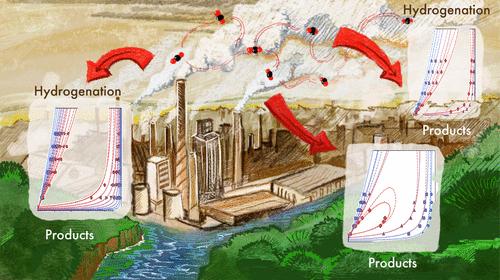当前位置:
X-MOL 学术
›
Ind. Eng. Chem. Res.
›
论文详情
Our official English website, www.x-mol.net, welcomes your feedback! (Note: you will need to create a separate account there.)
Assessing Thermodynamics Models for Phase Equilibria and Interfacial Properties Relevant to the Hydrogenation of Carbon Dioxide
Industrial & Engineering Chemistry Research ( IF 3.8 ) Pub Date : 2024-06-28 , DOI: 10.1021/acs.iecr.4c01518 Esteban Cea-Klapp 1 , Bastián González-Barramuño 1 , Nicolás F. Gajardo-Parra 2 , Alejandro Karelovic 1 , Héctor Quinteros-Lama 3 , Roberto I. Canales 2 , José Matías Garrido 1
Industrial & Engineering Chemistry Research ( IF 3.8 ) Pub Date : 2024-06-28 , DOI: 10.1021/acs.iecr.4c01518 Esteban Cea-Klapp 1 , Bastián González-Barramuño 1 , Nicolás F. Gajardo-Parra 2 , Alejandro Karelovic 1 , Héctor Quinteros-Lama 3 , Roberto I. Canales 2 , José Matías Garrido 1
Affiliation

|
The catalytic hydrogenation of carbon dioxide has become a novel technology of economic and environmental interest that allows the production of value-added products as energy alternatives to the current demand. As product distributions are highly dependent on process conditions such as reaction temperature, pressure, and H2/CO2 ratio, it is necessary to have reliable thermodynamic models that can characterize mixtures of reactants with products over a wide range of conditions. In this contribution, the accuracy of two hydrogen models applied through equations of state (EOS) framed within variations of the statistical associating fluid theory (SAFT) is compared. These models include perturbed-chain SAFT (PC-SAFT) EOS and SAFT of variable range and Mie potential (SAFT-VR Mie) EOS. This is accomplished by the depiction of the thermodynamic behavior of mixtures of hydrogen in the context of the hydrogenation of carbon dioxide, estimating the thermodynamic behavior of the relevant mixtures. In all of the cases, zero values for the binary adjustable parameters have been implemented, and both models of hydrogen were fitted from a hydrogen+decane mixture. Available experimental data of high-pressure phase equilibria, critical loci, and interfacial tensions is used to determine the accuracy of the hydrogen models by contrasting their respective predictive capabilities, determining that the overall performance of the one applied in the SAFT-VR Mie EOS is inferior compared to the PC-SAFT one. The average absolute deviations between model calculations and experimental data for vapor–liquid equilibrium are 35.8 % (pressure), 3.10 % (liquid composition), and 2.60 % (vapor composition) for PC-SAFT, and 26.3, 3.27, and 2.65% for SAFT-VR Mie, respectively.
中文翻译:

评估与二氧化碳加氢相关的相平衡和界面性质的热力学模型
二氧化碳催化加氢已成为一项具有经济和环境意义的新技术,可以生产增值产品作为当前需求的能源替代品。由于产物分布高度依赖于反应温度、压力和 H 2 /CO 2 比率等工艺条件,因此有必要拥有可靠的热力学模型来表征反应物混合物产品适用于各种条件。在这篇文章中,比较了通过状态方程(EOS)应用的两个氢模型的准确性,这些模型是在统计缔合流体理论(SAFT)的变化范围内构建的。这些模型包括扰动链 SAFT (PC-SAFT) EOS 和可变范围 SAFT 和 Mie 势 (SAFT-VR Mie) EOS。这是通过描述二氧化碳加氢背景下氢气混合物的热力学行为来实现的,并估计相关混合物的热力学行为。在所有情况下,二进制可调参数均已实现零值,并且两种氢气模型均由氢气+癸烷混合物拟合。高压相平衡、临界位点和界面张力的可用实验数据用于通过对比氢模型各自的预测能力来确定氢模型的准确性,从而确定 SAFT-VR Mie EOS 中应用的模型的整体性能为与 PC-SAFT 相比较差。 PC-SAFT 模型计算与气液平衡实验数据之间的平均绝对偏差为 35.8%(压力)、3.10%(液体成分)和 2.60%(蒸汽成分),PC-SAFT 为 26.3%、3.27% 和 2.65%。 SAFT-VR Mie,分别。
更新日期:2024-06-29
中文翻译:

评估与二氧化碳加氢相关的相平衡和界面性质的热力学模型
二氧化碳催化加氢已成为一项具有经济和环境意义的新技术,可以生产增值产品作为当前需求的能源替代品。由于产物分布高度依赖于反应温度、压力和 H 2 /CO 2 比率等工艺条件,因此有必要拥有可靠的热力学模型来表征反应物混合物产品适用于各种条件。在这篇文章中,比较了通过状态方程(EOS)应用的两个氢模型的准确性,这些模型是在统计缔合流体理论(SAFT)的变化范围内构建的。这些模型包括扰动链 SAFT (PC-SAFT) EOS 和可变范围 SAFT 和 Mie 势 (SAFT-VR Mie) EOS。这是通过描述二氧化碳加氢背景下氢气混合物的热力学行为来实现的,并估计相关混合物的热力学行为。在所有情况下,二进制可调参数均已实现零值,并且两种氢气模型均由氢气+癸烷混合物拟合。高压相平衡、临界位点和界面张力的可用实验数据用于通过对比氢模型各自的预测能力来确定氢模型的准确性,从而确定 SAFT-VR Mie EOS 中应用的模型的整体性能为与 PC-SAFT 相比较差。 PC-SAFT 模型计算与气液平衡实验数据之间的平均绝对偏差为 35.8%(压力)、3.10%(液体成分)和 2.60%(蒸汽成分),PC-SAFT 为 26.3%、3.27% 和 2.65%。 SAFT-VR Mie,分别。






































 京公网安备 11010802027423号
京公网安备 11010802027423号